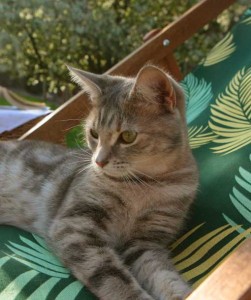Actually, there are many breeds (and mixed breeds) of domestic cats that are interested in swimming. Ultimately, when any mixed or pure breed cat ends up submerged in water, it will figure out a way to get itself to the edge of the shore, pool or bathtub through some form of flailing-limb movements that approximate swimming.
Bengals are descended from Asian cats that were recognized for their swimming prowess, so they are one of the most well-known breeds of swimming cats. Other breeds, such as the Turkish Van, Maine Coon and American Bobtail are also water lovers, and may occasionally take a dip in addition to pawing at the surface or playing with the drips coming down the shower wall.
Your purebred or mixed-breed cat may be a swimmer and you may not know it. Most cats that are in some form attracted to running water are more inclined to moisten their paws, muzzle or other body parts, and could even be prone to the occasional swim or splashing session in the safe confines of a sink or bathtub.
2. Is it true that cats don't sweat?Cats do not profusely sweat like people (who have sweat glands all over their bodies), but they do secrete moisture from their paw pads.
You may notice your cat leave moist paw prints if he's recently spent time in a warm environment (on a summer day or sunny windowsill, etc.) or has an elevated body temperature (hyperthermia, due to illness or infection).
Because the surface area of a paw pad is so small, releasing heat exclusively from the pads is an inadequate means for cats to cool themselves and maintain normal body temperature.
As a result, cats have developed other mechanisms to release heat. The moist surface of the respiratory tract (lungs and trachea) permits the exchange of heat from inside the body into the air.
You may see your cat breathing with an elevated respiratory rate (20-30 breaths per minute) or even exhibiting open-mouth breathing (panting) in attempt to rid heat from the body. Should you note your cat having an elevated respiratory rate or open mouth breathing despite being in a comfortable or climate-controlled environment, contact your veterinarian immediately.
3. I hear milk is better for kittens than water. True or false?Whether milk is a better choice than water for kittens depends on the source. If a kitten is able to nurse from its own mother, then the milk is a good source of hydration.
Milk contains lactose (milk sugar), which can have an osmotic effect in the digestive tract. More fluid in the intestines causes stools to become softer or even progress to diarrhea. Food changes or
infection (bacteria, viral, parasitic, etc.) are common reasons kittens may have diarrhea. Liquid lost through the digestive tract can quickly lead to life-threatening dehydration.Additionally, the enzyme lactase is needed to break down lactose. Most kittens are able to digest mother's milk, but there’s always the chance that they may not digest cow’s milk as easily.
Instead of giving your kitten cow's milk, it's better to feed it a milk replacement formula. These formulas have reduced lactose or no lactose, and are typically easier to digest than cow’s milk. Formula can help a developing feline digestive tract transition from mother’s milk to commercial kitten food.
4. My cat hates baths. Do all cats hate to be bathed by humans?Cats tend to shy away from water. This becomes more apparent when a cat is forced to have a bath against its will (never recommended).
Yet, as we discussed in the question about cat breeds that are known for their interest in water, some cats do take to water naturally and can even be excellent swimmers.
Your cat does not have to be of a specific breed to
have a bath. In general, you can acclimate your feline friend to water using these steps:
–Start early. The earlier in life that you can introduce your cat to the concept of getting wet, the more likely doing so will not be a traumatic experience.
–Be gentle. If you start by moistening your cat’s paws, then it’s less likely an aversion to water will occur when you progress to a full bath.
–Go slowly. The next step after moistening your cat's paws can be a sponge bath. Start by gradually moving from the paws up the limbs, over the back and eventually to the top of the head.
Once your cat is used to a sponge bath, then an introduction to the bathtub is a logical next step. You can even sponge bathe your cat inside the tub. Instead of abruptly submerging your cat into water, put him in the empty tub and slowly introduce a small amount of warm water to moisten the feet. If that is tolerated, then add more water so that the limbs and undercarriage of the body becomes wet.
If this process seems unreasonable to you, then seek help from either a professional groomer or a veterinarian’s office, where mild sedation can be used to reduce your cat's anxiety.
5. I read an article that said cats are able to drink water without getting their chin and whiskers wet, unlike their canine counterparts. Is that possible?Not all cats are fastidious with their drinking (and eating) habits — cats can get water and food on their whiskers, muzzle and other parts of the face. Additionally, depending on the length of a cat's whiskers, some contact with the water will be inevitable.
Drinking from a bowl that is full to the brim and elevated to approximately the height of your cat’s
elbows will permit an anatomically correct and comfortable neck position. This natural posture puts less strain on the neck (vertebrae, discs, etc.) and may reduce the chance your cat’s whiskers will get wet.

